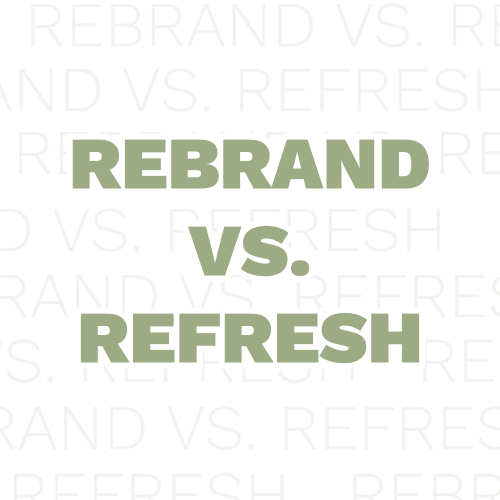Have you noticed a lot of popular brands announcing “a new look” lately? Companies like Walmart, KIND Snacks, and most recently the St. Louis Blues have all unveiled updated branding in the past year. As with many big reveals, reactions have been mixed. One of the most common criticisms?
“It looks exactly the same.”
These comments hint at a deeper disconnect between brands and their audiences. Does the average consumer actually care that a company tweaked its logo or added a new color to the palette? Do they notice a new font or updated messaging- or just see an expensive change that feels unnecessary?
That raises a valid question: Do brand refreshes and evolutions need to be announced at all? Or do they risk distracting from the company’s actual offering?
Let’s unpack that. But first, a quick refresher on what a refresh actually is.

What Is a Brand Refresh?
At its core, a brand refresh is an update to a company’s existing visuals or messaging that builds off the brand’s current identity. Think of it as an evolution- not a reinvention.
A refresh might include:
- Updating your color palette
- Switching to a more modern or accessible font
- Refining your logo (not redesigning it entirely)
- Adjusting your tone of voice or messaging style
The goal? Keep things relevant, polished, and aligned with where the brand is today. A good refresh honors a company’s roots while evolving the look and feel for what’s next.
So if a brand swaps its font for a serif, overhauls its logo, and completely changes its color scheme-is that still a refresh? Not quite. That’s when we start stepping into rebrand territory.
What Is a Rebrand?
A rebrand is a much deeper shift. It’s when a company strategically reimagines how it fits in the market- both visually and conceptually.
Rebrands typically involve:
- New logos, colors, and typography
- Rewritten brand messaging and tone
- Revised brand architecture or hierarchy
- Sometimes even a new name or positioning statement
Rebrands are usually driven by major changes: entering a new market, repositioning the business, distancing from past perceptions, or unifying multiple product lines. You can think of a rebrand as a reintroduction of your business to the world- starting from the ground up.
Are Brand Refreshes Important?
In short: yes.
Brand refreshes, when done intentionally, are a healthy part of growth. They help:
- Keep your visual identity from aging too quickly
- Maintain competitiveness in a changing market
- Add flexibility to your marketing efforts
- Ensure brand consistency across new platforms or channels
That doesn’t mean you need a full refresh every year. But gradually evolving over time can keep your brand feeling modern without losing recognition.
Should You Announce a Brand Refresh?
In most cases, no- a brand refresh doesn’t need to be a grand reveal. Big announcements often backfire, especially if the changes are minimal. Walmart and KIND Snacks both faced backlash not because their branding was bad, but because their announcements spotlighted very subtle tweaks, mostly to their logos.
If you do plan to announce a refresh, I'd recommend leading with the bigger-picture improvements (like what’s changed in the customer experience) and save the design details for last.
Is It Ever Okay to Announce a Brand Refresh?
While most refreshes don’t need a formal unveiling, there are exceptions- especially for brands that thrive on momentum and seasonal change.
Take sports teams, for example. The St. Louis Blues are a great case. Fans expect some level of reinvention each season: new merchandise, updated in-game graphics, maybe even alternate uniforms or branding elements. A visual refresh becomes part of the fan experience.
The same logic applies to brands with “off-seasons” or cyclical offerings- think annual events, product drops, or entertainment-focused businesses. For these companies, a brand refresh can be an effective way to build anticipation and re-engage their audience.
That said, the same rule still applies: start with the big stuff. Lead with what's new and exciting-then, if it’s relevant, share the visual tweaks. This way, the refresh becomes part of a broader story instead of the main headline.
Should You Announce a Rebrand?
Absolutely. A rebrand is a big deal- and it deserves to be treated like one. Unlike a subtle refresh, a full rebrand is a strategic pivot. It often signals a new chapter in your business or a total reinvention of how you want to be seen.
This is the moment to reintroduce your company to the world with intention and energy. Whether it’s through a social campaign, a refreshed website, or messaging that captures the new direction, a rebrand rollout should clearly communicate the “why” behind the change- and where you're headed next.
Final Thoughts
Whether you’re refreshing or rebranding, the goal is the same: to make sure your brand reflects where your business is today and where it’s going.
Most people won’t notice your new font or color tweak. But they will notice if your brand feels outdated, inconsistent, or disconnected from your product or experience. Change doesn’t need to be loud to be effective- but it should always be thoughtful.



